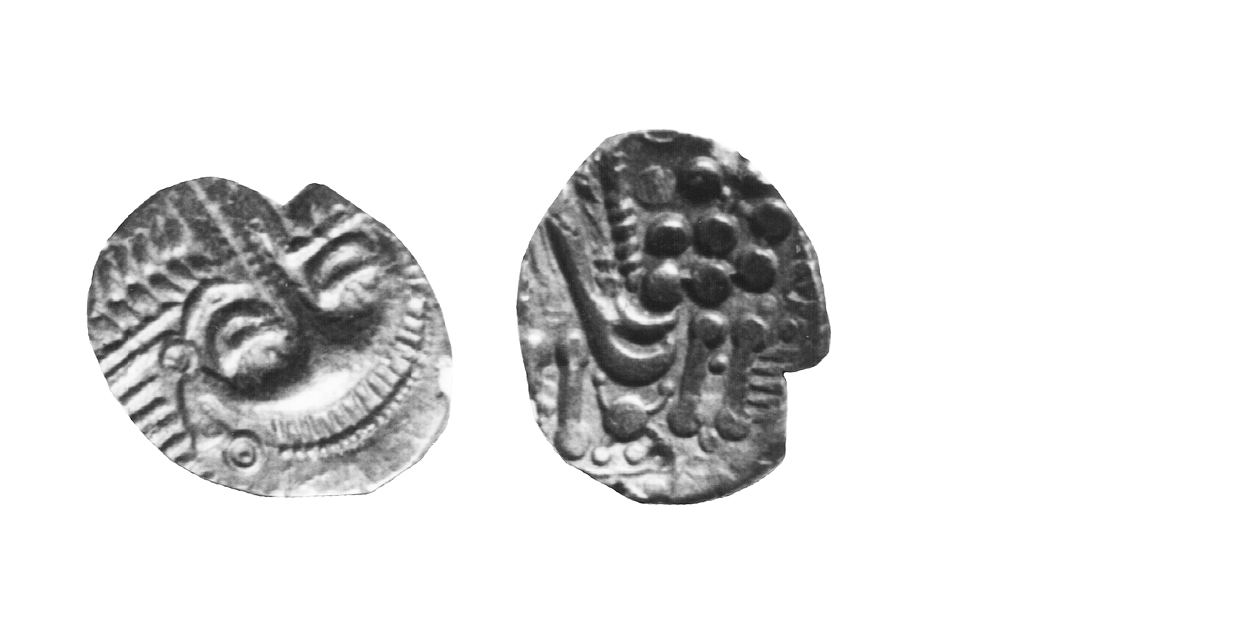Numismatic Articles
Van Arsdell 2014d (Info)
Modern Celtic Fakes 4 – The best Haslemere forgeries
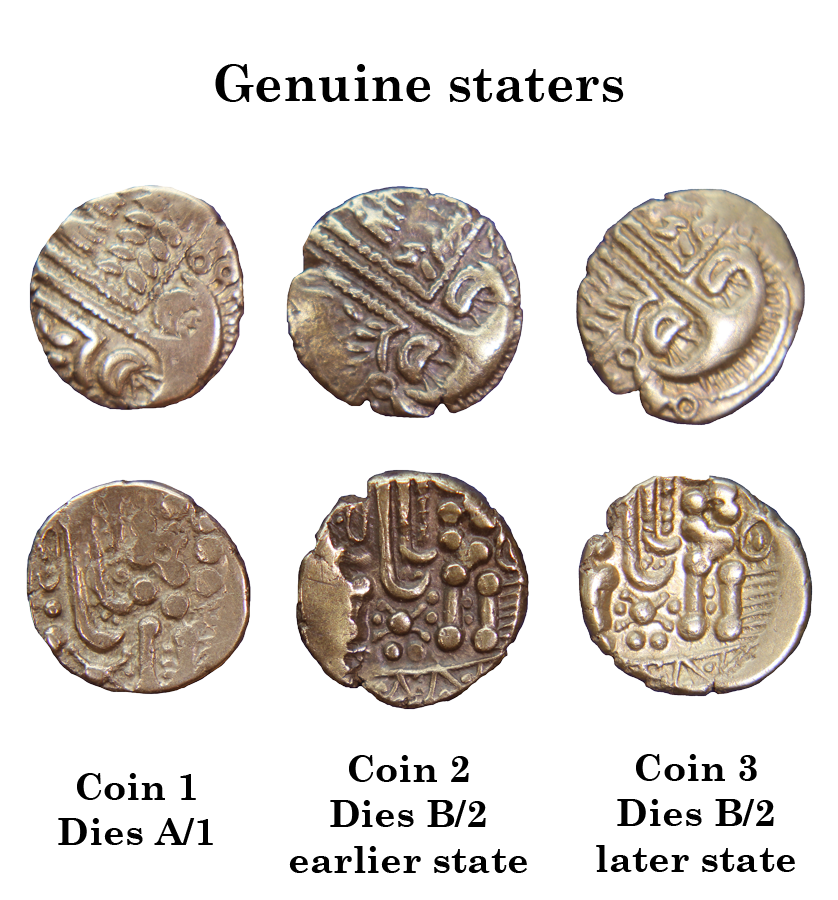
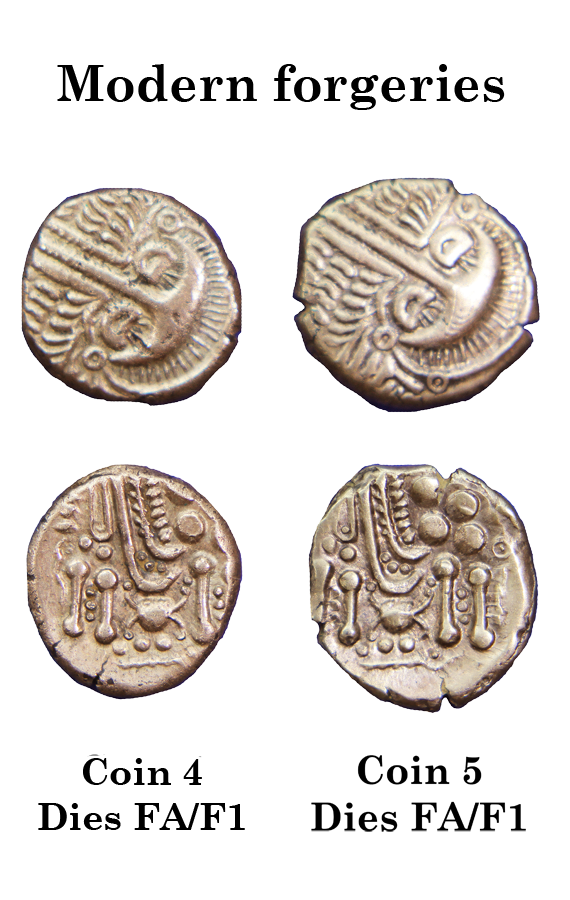
The images above show three genuine Cheriton staters (info) and two modern forgeries. Coins 1, 2 and 3 are genuine, 4 and 5 are modern forgeries. The following descriptions are written from direct observations of the coins. The five were viewed together, so the comparisons of die cutting are also direct. Photographs were never used in this analysis.
This article describes the die-cutting errors on the two forgeries, and its findings apply to the two fakes shown above. I have not been shown other examples, thus I cannot comment about other pieces that may exist. None of this die-cutting analysis has ever been published, and thus the forger has never been warned about his errors.
The two fakes are of such good quality, that there is only slight proof they are from the hand of the Haslemere Forger. However, the die-cutting errors are consistent with the quality of work he would have been capable of after 1986. It is possible the forger trained others in the craft (as Becker trained Zindel in the 1820s (info). On balance however, there is just enough evidence to assign the two fakes to the Haslemere Forger.
The story unfolds
The first coin appeared in June 1986. The die cutting is consistent with the other two genuine coins, though this one is struck from different dies.
The second coin appeared in December 1988. It’s struck from the same obverse die as Sir John Evans’ example, found in 1870 and now in the British Museum.
Coin 4 appeared late in 1991, and was shown to me in June 1992. It had aroused no suspicions when it first appeared. By the fall of 1992, I became uneasy about it, and later in the year, I suggested it needed further study to establish its authenticity.
By February 1993, I began to confirm my suspicions about Coin 4. Cheriton staters were extremely rare at the time. The Haslemere Forger never anticipated that anyone would have two genuine examples to compare side-by-side with his work.
During the course of the investigations, coin 4 was provided with a “Certificate of Authenticity” from the “finder”. The certificate came with a “findspot” duly noted and a copy of an archaeological excavation report from a site in a nearby field. The archaeological report, entirely genuine, was included to suggest the fake findspot could plausibly yield Iron Age coins.
By mid 1993, my suspicions increased, so I sought out further examples to get to the bottom of the matter. Coin 5 (fake) was located November 1993, and Coin 3 (genuine) in December 1993.
Authenticators always speak of some “feeling” that initially tips them off. This does little to give people the tools they need to spot fakes, so I’ll try and offer something more concrete. My initial reaction to Coin 4 was the die cutting was too “neat and tidy” compared to coins 1 and 2. The genuine coins looked amateurish compared to the coin that eventually was proven to be a fake – the fake was too good.
Eventually, Eric McFadden of CNG, Chris Rudd and I joined forces to commission a set of metallurgical analyses and get more evidence. Peter Northover at Oxford ran the tests. They revealed coin 4 was undoubtedly a modern fabrication. This work has never been published and is still being withheld at this time. Eventually, the full metallurgical story ought to be published.
The die cutting analysis
Genuine Cheriton staters are unusual amongst Ancient British coins in that the dies and the die-cutting work are fairly incompetent productions. Every thing about them suggests rushed work carried out by beginners. This would be the first instance in which the forger was actually producing better dies than the ancients.
So few Cheritons existed in 1991, that the forger likely used photographs to guide his work. Without a genuine coin to study, he would have had little idea how the original dies were made – this would be his downfall.
The metal used to make the ancient dies was too brittle, and coins 2 and 3 show a large cud (also called a “piece-out”) on the reverse die. The cud becomes larger and obliterates more of the image on coin 3. Thus, coin 3 shows a later die state than coin 2. To make matters worse, the die-cutter used techniques that caused the dies to fail even faster.
Unusual die cutting on genuine coins – long lines on the obverse
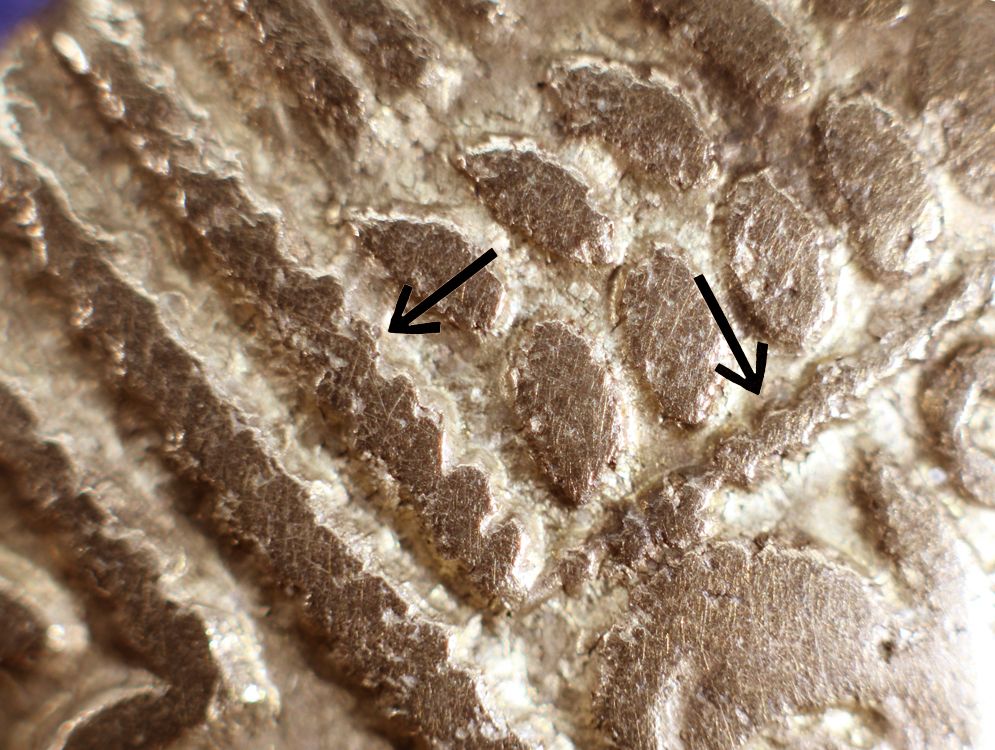
Coin 1 (genuine), though very worn, shows the die cutting best. The three long lines running diagonally from the upper left aren’t cut as one would expect. Rather than engraving solid lines, the die cutter made them using a line of dots instead (arrows). The dots were produced by a set of small holes in the die. As the brittle dies were used, the walls between the holes broke down. Coin 1 shows the appearance of the dots before the dies became too damaged – the areas between the dots are beginning to fill in.
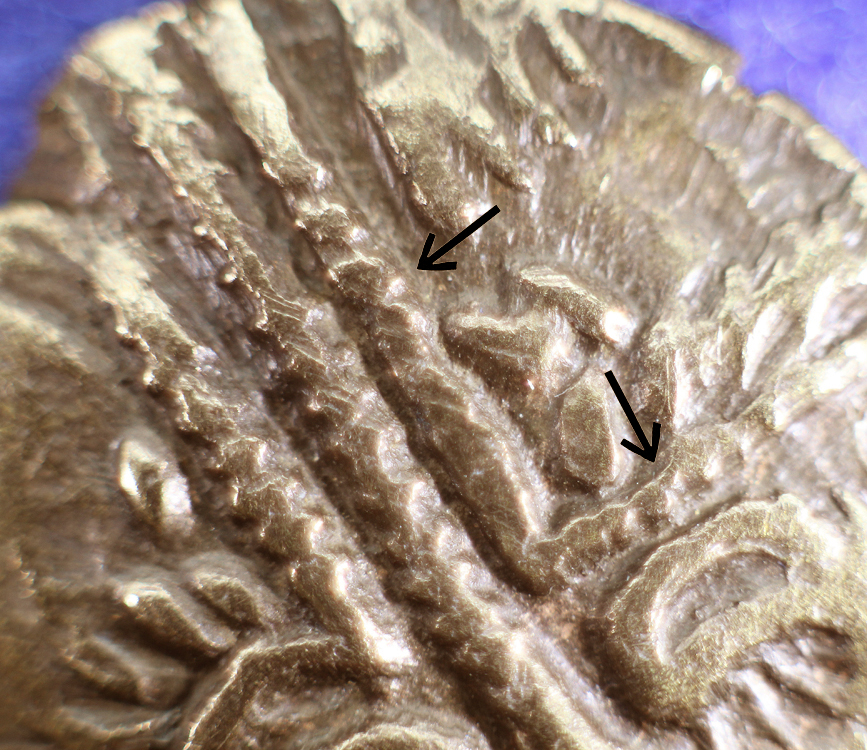
On coin 2 (genuine), struck from dies that have become heavily damaged, the dots have begun to merge into a single line. Only the appearance of raggedness suggests the line was originally something else (arrows).
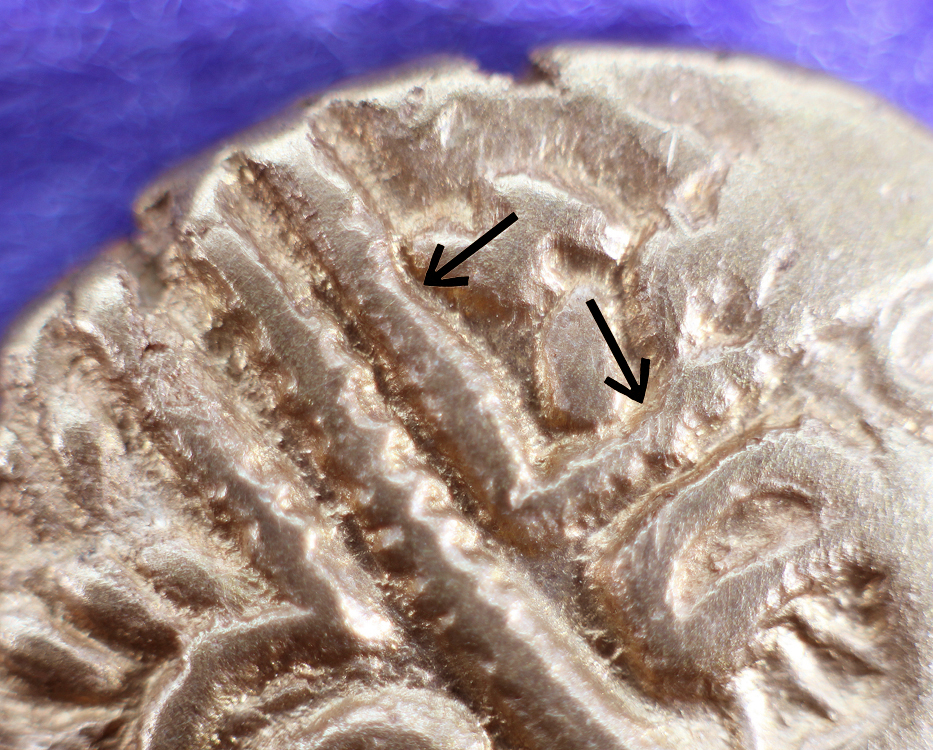
Coin 3 (struck from the same dies as coin 2), shows further die damage. The rows of dots have now merged to produce a line with very small appendages (arrows).
When the forger cut his dies, he must have been looking at a photograph of such a coin – ones struck from dies in an advanced state of deterioration. This would trip him up. He needed a real coin to look at, and he didn’t have one.
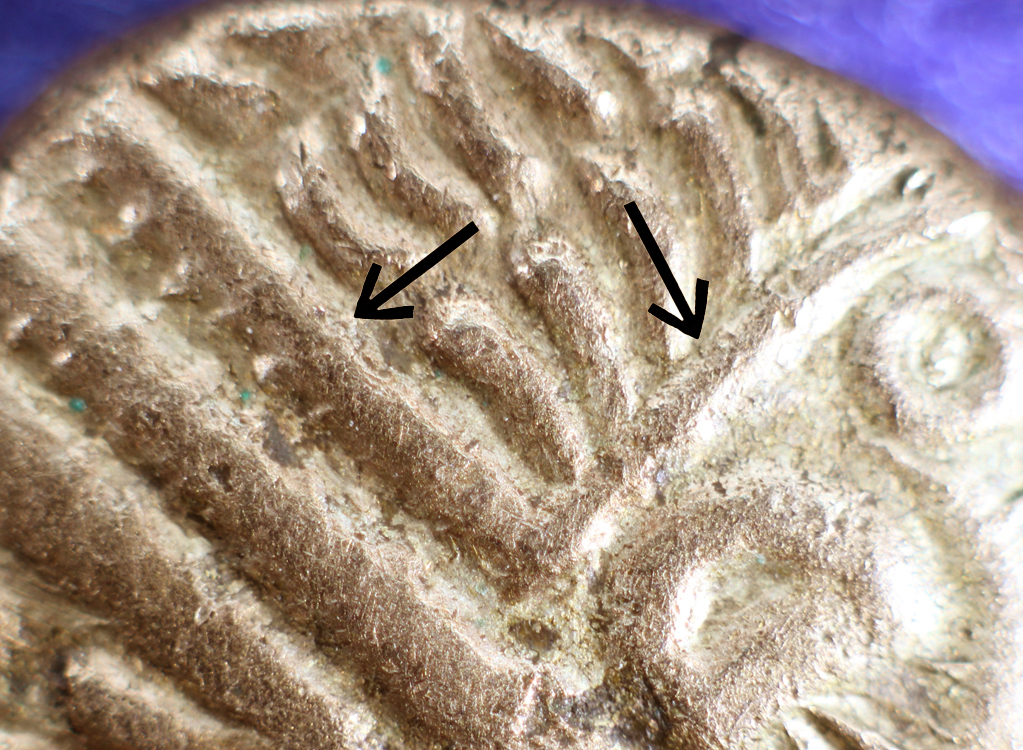
On coin 4 (fake) the line of dots is nothing more than an engraved line. Yet the coin shows no evidence of die damage – it’s struck from fresh dies. The forger cut small appendages along the line to duplicate the image on his photo. But he never understood what he was trying to reproduce.
The coin he copied must have been stuck from a set of worn dies – the row of dots simply looked like a single line. He saw the remnants of the individual dots as appendages on the line, and replicated what he saw.
Without a real coin, or at least a set of detailed microphotographs to guide him, the forger was doomed.
What's under the line?….don't know, let's leave it empty

Coin 5 (fake) shows nothing below the exergual line. The details on the 1870 Cheriton (the one most authors use as a plate coin) hint at the imagery, but it would take later finds to show plainly what should be there. The forger was too unsure to engrave anything in the exergue.
Looking further, the exergual line on the fake makes a silly detour around a previously punched pellet – nothing like this occurs on genuine Cheritons.
More mistakes on the reverse – the horse’s neck
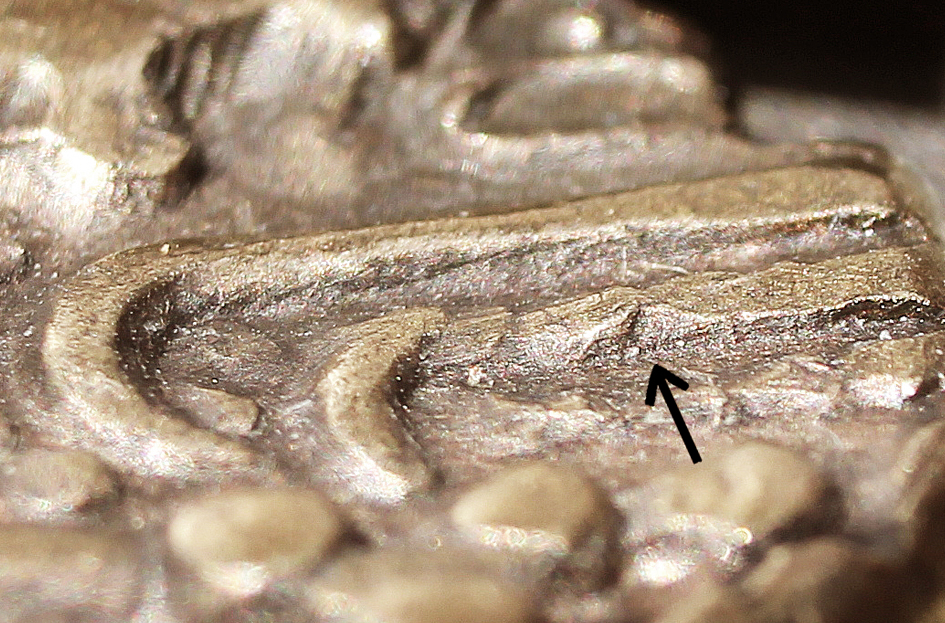
On coin 2 (genuine), the two lines of the horse’s neck appear as lines, not rows of dots. It is difficult to tell whether they started out as dots or not. But there are a few indentations to indicate that one of the lines was originally a row of dots (arrow). This detail has suffered from 2000 years in the ground and it’s difficult to photograph.
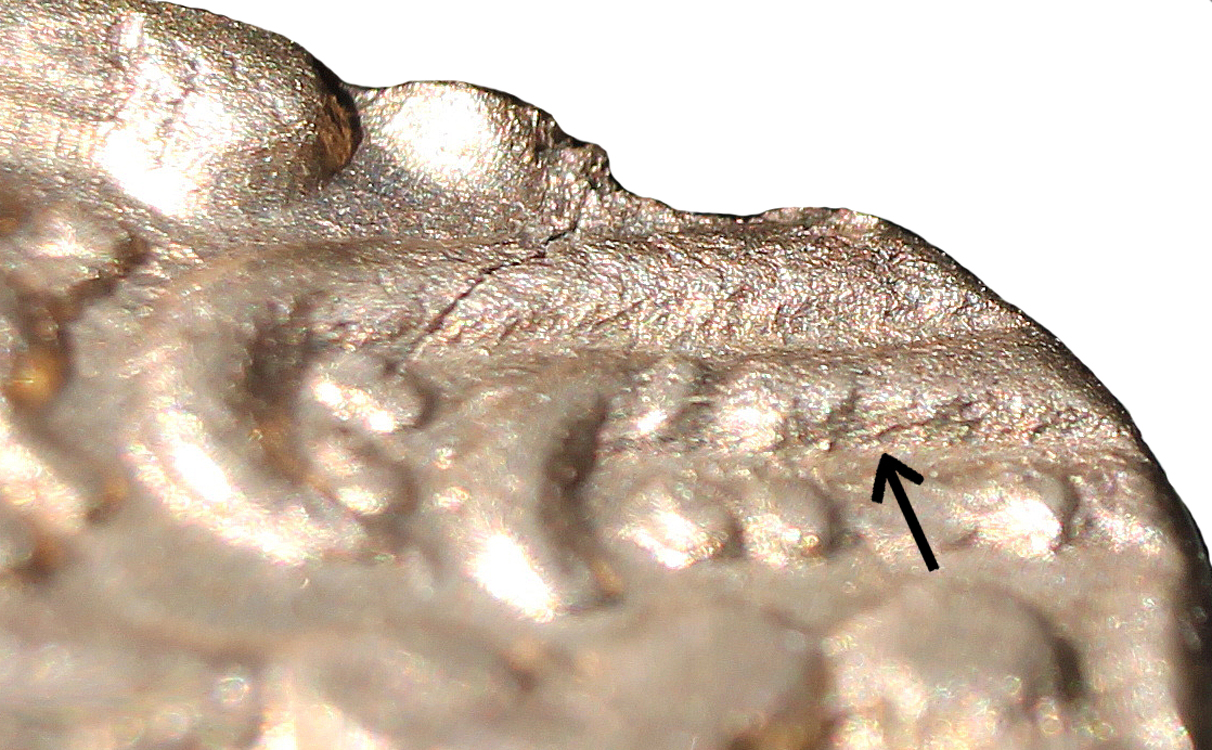
Coin 3 (genuine) is somewhat better preserved. Better evidence of the row of dots survives, but the greater die wear can also be seen. The arrow points to the same place on the die, additional metal now fills in the gap between the two dots.
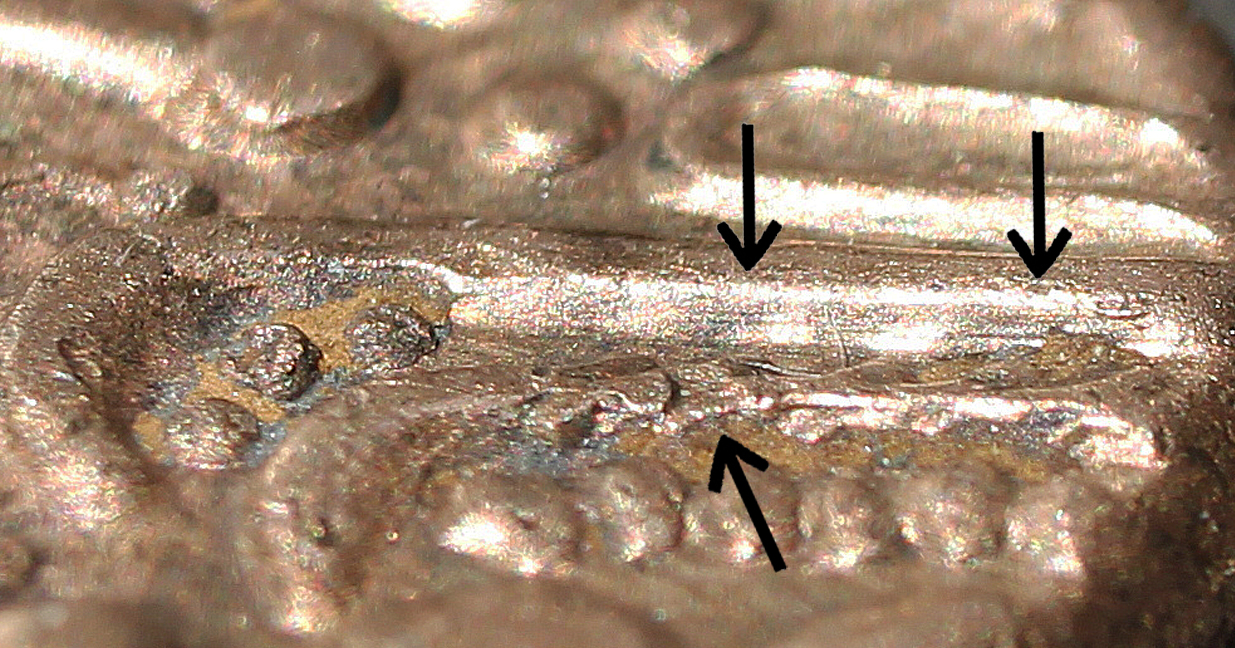
On coin 4 (fake), this detail is engraved as series of overlapping cuts. On earlier Haslemere forgeries, the multiple cuts would have produced pronounced Steps or Split End Errors, exposing the fake (info). The series of individual cuts can just be seen on the lower line (bottom arrow).
The upper line has extremely fine striations running along the side (two top arrows). These are probably caused by the forger's attempts at die dressing (info). The upper line with its die dressing, and the lower line which preserves the forger’s individual cuts, support the idea that this is the work of the Haslemere Forger.
Errors with the rays
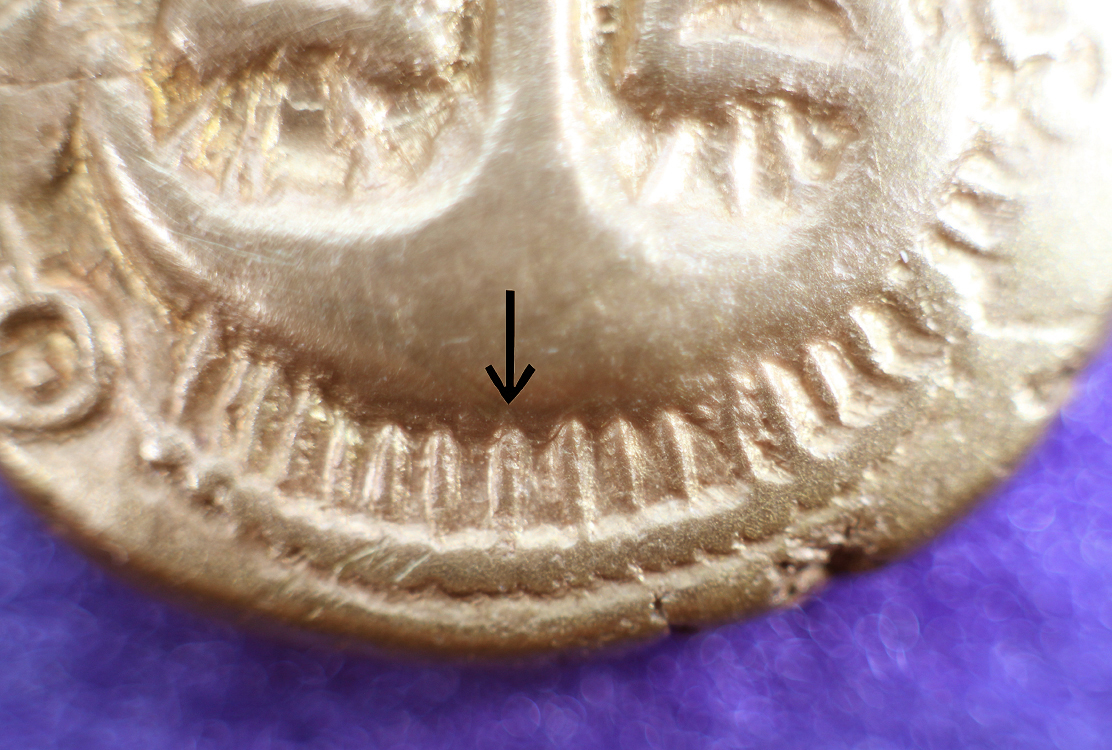
The obverse of a Cheriton stater shows a series of rays emanating from the broad crescent at the bottom of the design. As seen on coin 3 (genuine), these were punched into the die with an elliptical punch. The rays look like little grains of rice (arrow). These punch marks are fairly light, and the resulting rays lie close to the field of the coin – they don’t rise over the surface of the broad crescent.
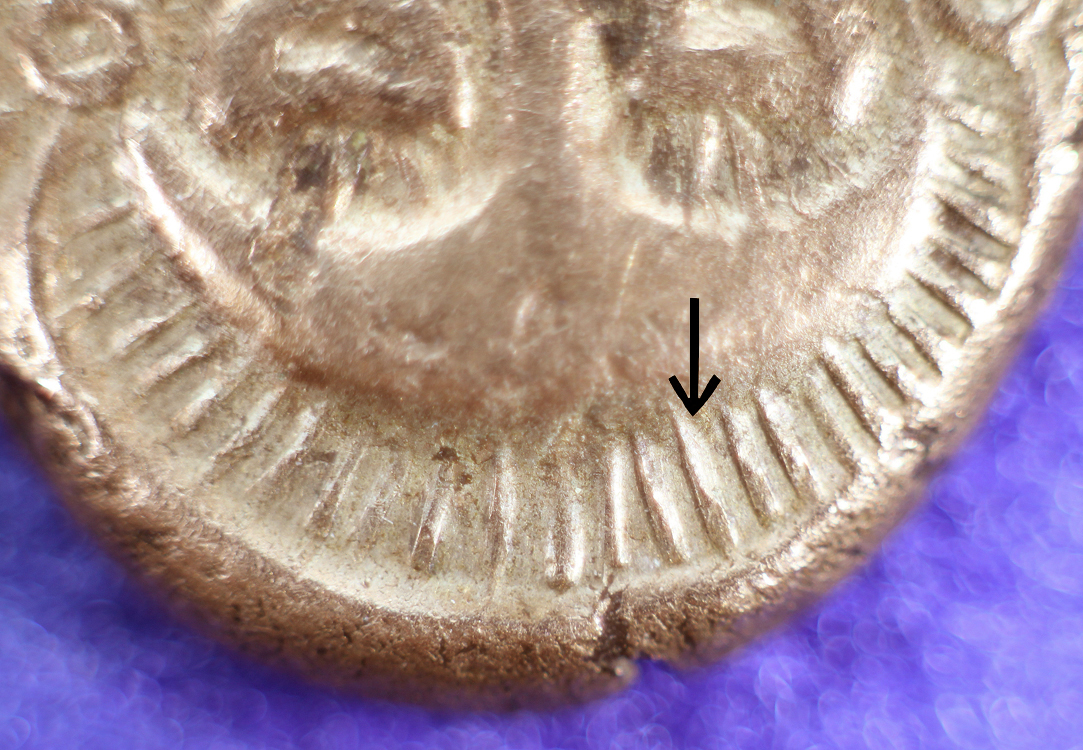
On coin 4 (fake), the forger’s mistakes are plain to see. The rays are engraved lines instead of punched ellipses. It appears the forger cut half of each ray in one direction, than cut the rest in the opposite one. As a result, the rays lack a smooth upper surface. They show two planes, which reflect light in different directions. The arrow shows the effect plainly – the surface of the ray is lighter on one half, and darker on the other.
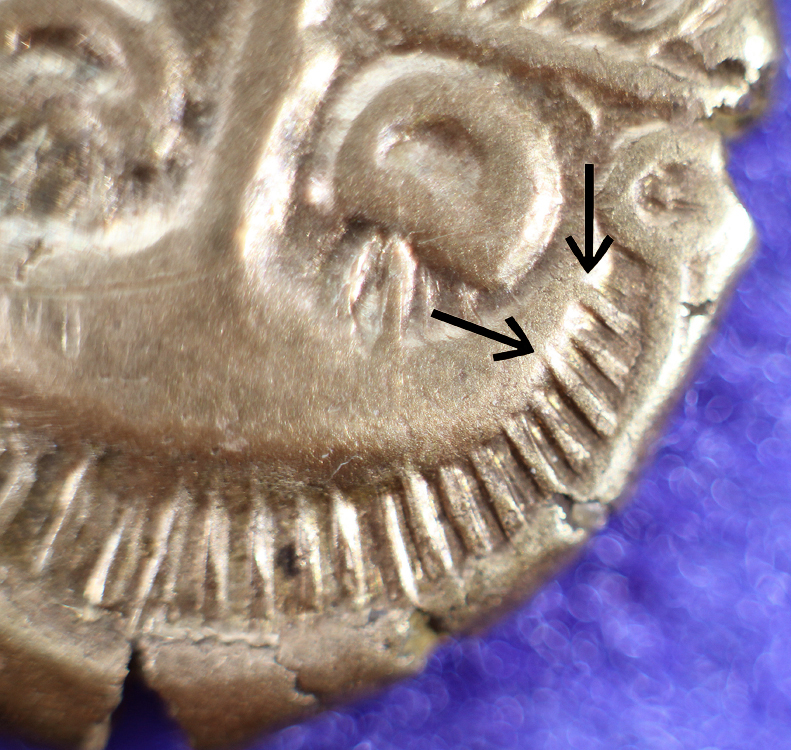
Coin 5 (fake) shows another error, accentuated here by lighting the coin differently. The rays have been cut too deeply, such that they jump over the surface of the broad crescent (arrows).
And one more thing….
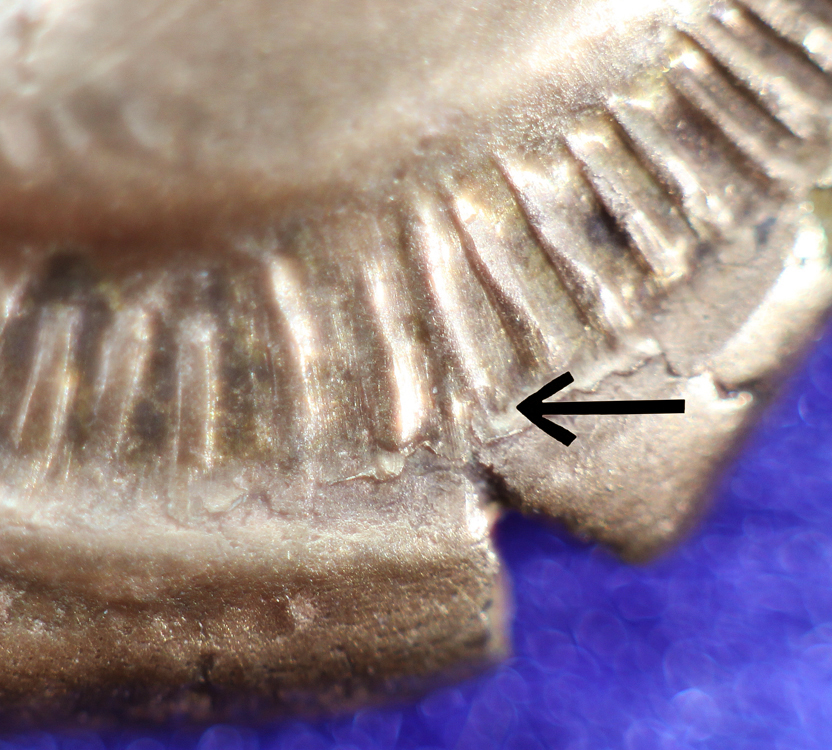
Coin 5 (fake) shows that one of the rays has a Split End Error at the bottom (arrow). This is probably the best indication the dies were cut by the Haslemere Forger.
Postscript
The forger must have been mightily disappointed these superb fakes were unmasked so quickly. He’d been improving his work for many years. He obviously worked very hard on this particular set of dies. Unfortunately, without a sufficient number of genuine coins to guide him, he couldn’t cut a set of convincing dies.
What would the forger have learned from this? He should have realized that trying to cut dies for known types was a fool’s game. Eventually, somebody comparing his fakes to genuine coins would spot mistakes and expose them. Reportedly, at least 40 fakes were involved (info) and giving back the money would have been an annoyance. This would be the second time it had happened since 1984.
If the forger wanted to continue going, what could he do? He could resort to casting copies, but casting technology wasn’t quite good enough in 1993. He could only get away with his criminal activity if he cut dies for “new types”. These could never be compared to genuine coins – there would be no genuine coins to expose his fakes.
Three lessons to be learned:
- The first is that authenticating coins from photographs really is the fool’s game here. Just as the forger was misled, any authenticator will likely make the same kinds of mistakes. At best, obvious fakes may be spotted, but competent forgeries will not.
- The second lesson is that students of the series need to take a skeptical approach and reject “new types” until they are proven genuine. A cursory examination with a low magnification lens and the assurance the coin has a recorded findspot do not constitute any sort of proof.
- The third is “Certificates of Authenticity” and “knowing your sources” aren’t good defenses in these situations.
End

